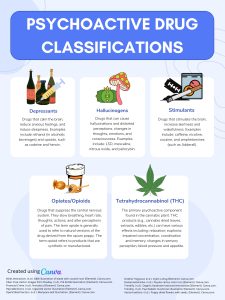1.2 Psychoactive Drug Classifications & Effects
Jacqueline Lewis and Christine Miller
Psychoactive drugs are divided into different classes based on their pharmacological effects. Several classes are listed in the infographic below, along with examples of commonly used drugs in each class.

Access the Word file containing text for the Drug Classifications infographic
Many psychoactive drugs have multiple effects, so they may be placed in more than one class. An example is MDMA (see image below), which may act as both a stimulant and a hallucinogen. MDMA’s efficacy as a treatment for post-traumatic stress disorder (PTSD) and other types of anxiety disorders, is showing promise in some recent studies (Stone, August 14, 2019). THC is another substance that is hard to classify, as it can act as a stimulant, a depressant, and/or an hallucinogen. This is why THC is often placed in a category of its own.

VIDEO: Overview of Psychoactive Drugs
The following video provides an overview of the different classifications of psychoactive substances.

